Microsoft Entra Connect user sign-in options
Microsoft Entra Connect allows your users to sign in to both cloud and on-premises resources by using the same passwords. This article describes key concepts for each identity model to help you choose the identity that you want to use for signing in to Microsoft Entra ID.
If you’re already familiar with the Microsoft Entra identity model and want to learn more about a specific method, see the appropriate link:
- Password hash synchronization with Seamless Single Sign-on (SSO)
- Pass-through authentication with Seamless Single Sign-on (SSO)
- Federated SSO (with Active Directory Federation Services (AD FS))
- Federation with PingFederate
Note
It is important to remember that by configuring federation for Microsoft Entra ID, you establish trust between your Microsoft Entra tenant and your federated domains. With this trust federated domain users will have access to Microsoft Entra cloud resources within the tenant.
Choosing the user sign-in method for your organization
The first decision of implementing Microsoft Entra Connect is choosing which authentication method your users will use to sign in. It's important to make sure you choose the right method that meets your organization's security and advanced requirements. Authentication is critical, because it will validate user's identities to access apps and data in the cloud. To choose the right authentication method, you need to consider the time, existing infrastructure, complexity, and cost of implementing your choice. These factors are different for every organization and might change over time.
Microsoft Entra ID supports the following authentication methods:
- Cloud Authentication - When you choose this authentication method Microsoft Entra ID handles the authentication process for user's sign-in. With cloud authentication you can choose from two options:
- Password hash synchronization (PHS) - Password Hash Sync enables users to use the same username and password that they use on-premises without having to deploy any additional infrastructure besides Microsoft Entra Connect.
- Pass-through authentication (PTA) - This option is similar to password hash sync, but provides a simple password validation using on-premises software agents for organizations with strong security and compliance policies.
- Federated authentication - When you choose this authentication method Microsoft Entra ID will hand off the authentication process to a separate trusted authentication system, such as AD FS or a third-party federation system, to validate the user's sign-in.
For most organizations that just want to enable user sign-in to Microsoft 365, SaaS applications, and other Microsoft Entra ID-based resources, we recommend the default password hash synchronization option.
For detailed information on choosing an authentication method, see Choose the right authentication method for your Microsoft Entra hybrid identity solution
Password hash synchronization
With password hash synchronization, hashes of user passwords are synchronized from on-premises Active Directory to Microsoft Entra ID. When passwords are changed or reset on-premises, the new password hashes are synchronized to Microsoft Entra ID immediately so that your users can always use the same password for cloud resources and on-premises resources. The passwords are never sent to Microsoft Entra ID or stored in Microsoft Entra ID in clear text. You can use password hash synchronization together with password write-back to enable self-service password reset in Microsoft Entra ID.
In addition, you can enable Seamless SSO for users on domain-joined machines that are on the corporate network. With single sign-on, enabled users only need to enter a username to help them securely access cloud resources.
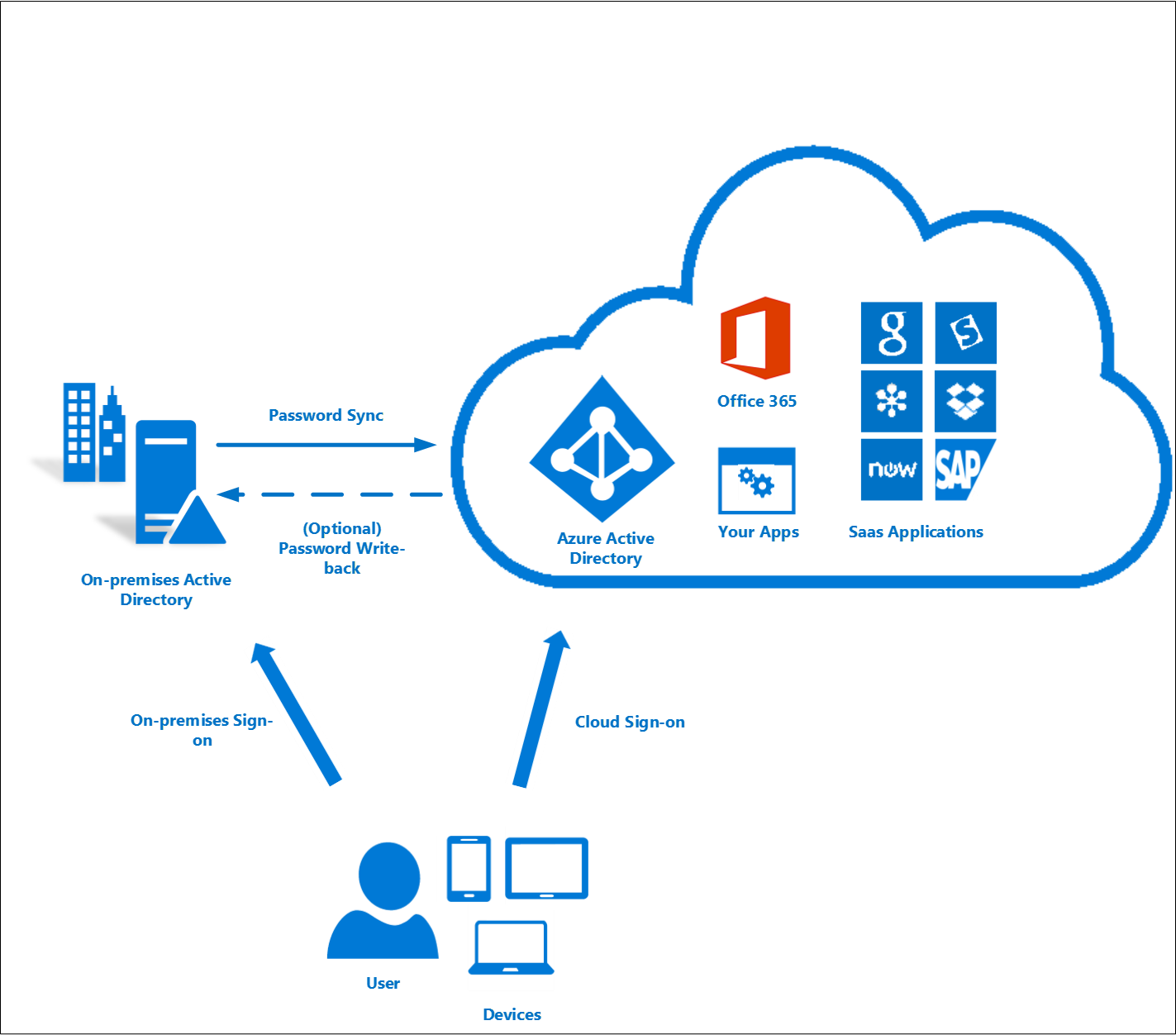
For more information, see the password hash synchronization article.
Pass-through authentication
With pass-through authentication, the user’s password is validated against the on-premises Active Directory controller. The password doesn't need to be present in Microsoft Entra ID in any form. This allows for on-premises policies, such as sign-in hour restrictions, to be evaluated during authentication to cloud services.
Pass-through authentication uses a simple agent on a Windows Server 2012 R2 domain-joined machine in the on-premises environment. This agent listens for password validation requests. It doesn't require any inbound ports to be open to the Internet.
In addition, you can also enable single sign-on for users on domain-joined machines that are on the corporate network. With single sign-on, enabled users only need to enter a username to help them securely access cloud resources.
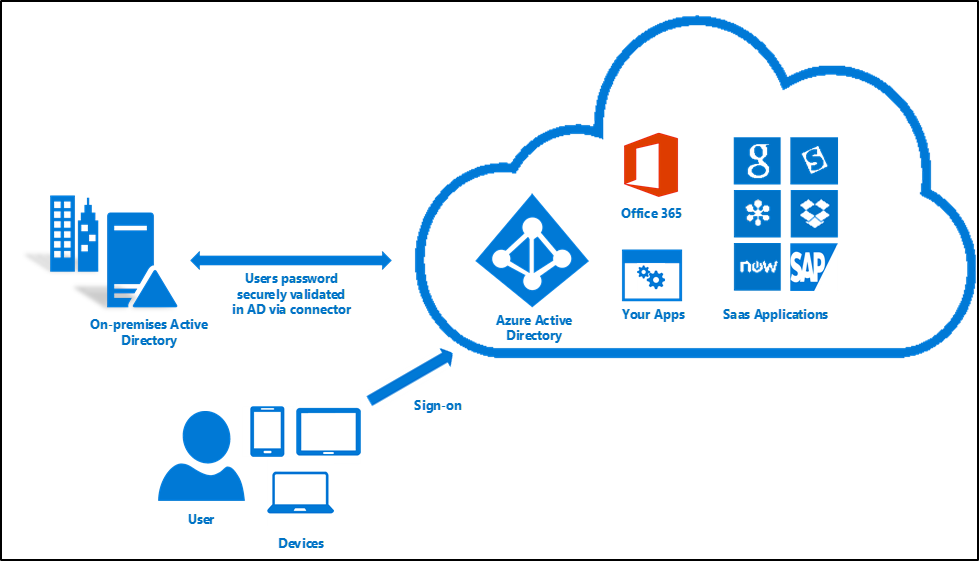
For more information, see:
Federation that uses a new or existing farm with AD FS in Windows Server 2012 R2
With federated sign-in, your users can sign in to Microsoft Entra ID-based services with their on-premises passwords. While they're on the corporate network, they don't even have to enter their passwords. By using the federation option with AD FS, you can deploy a new or existing farm with AD FS in Windows Server 2012 R2. If you choose to specify an existing farm, Microsoft Entra Connect configures the trust between your farm and Microsoft Entra ID so that your users can sign in.
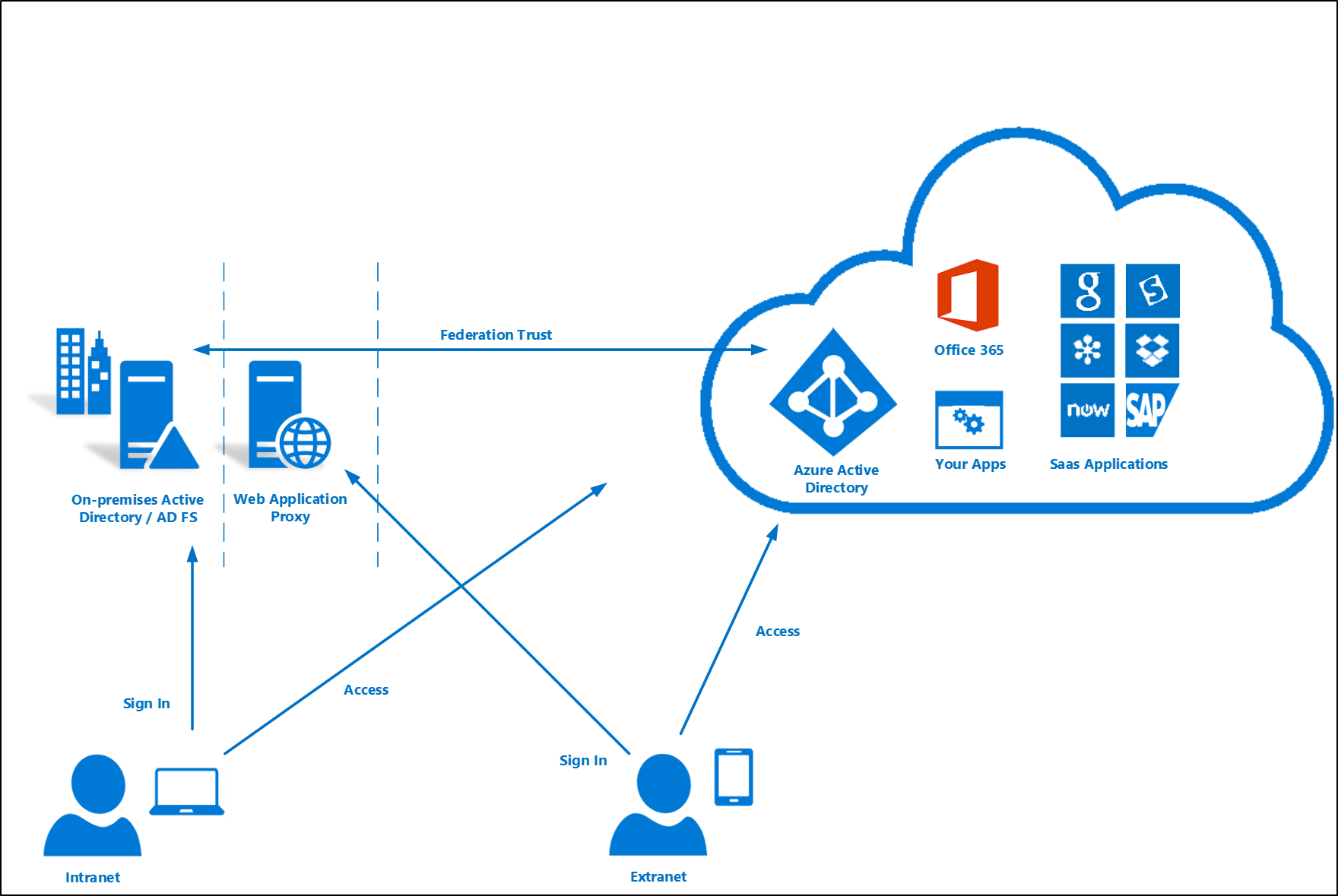
Deploy federation with AD FS in Windows Server 2012 R2
If you're deploying a new farm, you need:
- A Windows Server 2012 R2 server for the federation server.
- A Windows Server 2012 R2 server for the Web Application Proxy.
- A .pfx file with one TLS/SSL certificate for your intended federation service name. For example: fs.contoso.com.
If you're deploying a new farm or using an existing farm, you need:
- Local administrator credentials on your federation servers.
- Local administrator credentials on any workgroup servers (not domain-joined) that you intend to deploy the Web Application Proxy role on.
- The machine that you run the wizard on to be able to connect to any other machines that you want to install AD FS or Web Application Proxy on by using Windows Remote Management.
For more information, see Configuring SSO with AD FS.
Federation with PingFederate
With federated sign-in, your users can sign in to Microsoft Entra ID-based services with their on-premises passwords. While they're on the corporate network, they don't even have to enter their passwords.
For more information on configuring PingFederate for use with Microsoft Entra ID, see PingFederate integration with Microsoft Entra ID and Microsoft 365.
For information on setting up Microsoft Entra Connect using PingFederate, see Microsoft Entra Connect custom installation
Sign in by using an earlier version of AD FS or a third-party solution
If you've already configured cloud sign-in by using an earlier version of AD FS (such as AD FS 2.0) or a third-party federation provider, you can choose to skip user sign-in configuration through Microsoft Entra Connect. This will enable you to get the latest synchronization and other capabilities of Microsoft Entra Connect while still using your existing solution for sign-in.
For more information, see the Microsoft Entra third-party federation compatibility list.
User sign-in and user principal name
Understanding user principal name
In Active Directory, the default user principal name (UPN) suffix is the DNS name of the domain where the user account was created. In most cases, this is the domain name that's registered as the enterprise domain on the Internet. However, you can add more UPN suffixes by using Active Directory Domains and Trusts.
The UPN of the user has the format username@domain. For example, for an Active Directory domain named "contoso.com", a user named John might have the UPN "john@contoso.com". The UPN of the user is based on RFC 822. Although the UPN and email share the same format, the value of the UPN for a user might or might not be the same as the email address of the user.
User principal name in Microsoft Entra ID
The Microsoft Entra Connect wizard uses the userPrincipalName attribute or lets you specify the attribute (in a custom installation) to be used from on-premises as the user principal name in Microsoft Entra ID. This is the value that is used for signing in to Microsoft Entra ID. If the value of the userPrincipalName attribute doesn't correspond to a verified domain in Microsoft Entra ID, then Microsoft Entra ID replaces it with a default .onmicrosoft.com value.
Every directory in Microsoft Entra ID comes with a built-in domain name, with the format contoso.onmicrosoft.com, that lets you get started using Azure or other Microsoft services. You can improve and simplify the sign-in experience by using custom domains. For information on custom domain names in Microsoft Entra ID and how to verify a domain, see Add your custom domain name to Microsoft Entra ID.
Microsoft Entra sign-in configuration
Microsoft Entra sign-in configuration with Microsoft Entra Connect
The Microsoft Entra sign-in experience depends on whether Microsoft Entra ID can match the user principal name suffix of a user that's being synced to one of the custom domains that are verified in the Microsoft Entra directory. Microsoft Entra Connect provides help while you configure Microsoft Entra sign-in settings, so that the user sign-in experience in the cloud is similar to the on-premises experience.
Microsoft Entra Connect lists the UPN suffixes that are defined for the domains and tries to match them with a custom domain in Microsoft Entra ID. Then it helps you with the appropriate action that needs to be taken. The Microsoft Entra sign-in page lists the UPN suffixes that are defined for on-premises Active Directory and displays the corresponding status against each suffix. The status values can be one of the following:
| State | Description | Action needed |
|---|---|---|
| Verified | Microsoft Entra Connect found a matching verified domain in Microsoft Entra ID. All users for this domain can sign in by using their on-premises credentials. | No action is needed. |
| Not verified | Microsoft Entra Connect found a matching custom domain in Microsoft Entra ID, but it isn't verified. The UPN suffix of the users of this domain will be changed to the default .onmicrosoft.com suffix after synchronization if the domain isn't verified. | Verify the custom domain in Microsoft Entra ID. |
| Not added | Microsoft Entra Connect didn't find a custom domain that corresponded to the UPN suffix. The UPN suffix of the users of this domain will be changed to the default .onmicrosoft.com suffix if the domain isn't added and verified in Azure. | Add and verify a custom domain that corresponds to the UPN suffix. |
The Microsoft Entra sign-in page lists the UPN suffixes that are defined for on-premises Active Directory and the corresponding custom domain in Microsoft Entra ID with the current verification status. In a custom installation, you can now select the attribute for the user principal name on the Microsoft Entra sign-in page.

You can click the refresh button to re-fetch the latest status of the custom domains from Microsoft Entra ID.
Selecting the attribute for the user principal name in Microsoft Entra ID
The attribute userPrincipalName is the attribute that users use when they sign in to Microsoft Entra ID and Microsoft 365. You should verify the domains (also known as UPN suffixes) that are used in Microsoft Entra ID before the users are synchronized.
We strongly recommend that you keep the default attribute userPrincipalName. If this attribute is nonroutable and can't be verified, then it's possible to select another attribute (email, for example) as the attribute that holds the sign-in ID. This is known as the Alternate ID. The Alternate ID attribute value must follow the RFC 822 standard. You can use an Alternate ID with both password SSO and federation SSO as the sign-in solution.
Note
Using an Alternate ID isn't compatible with all Microsoft 365 workloads. For more information, see Configuring Alternate Login ID.
Different custom domain states and their effect on the Azure sign-in experience
It's very important to understand the relationship between the custom domain states in your Microsoft Entra directory and the UPN suffixes that are defined on-premises. Let's go through the different possible Azure sign-in experiences when you're setting up synchronization by using Microsoft Entra Connect.
For the following information, let's assume that we're concerned with the UPN suffix contoso.com, which is used in the on-premises directory as part of UPN--for example user@contoso.com.
Express settings/Password hash synchronization
| State | Effect on user Azure sign-in experience |
|---|---|
| Not added | In this case, no custom domain for contoso.com has been added in the Microsoft Entra directory. Users who have UPN on-premises with the suffix @contoso.com won't be able to use their on-premises UPN to sign in to Azure. They'll instead have to use a new UPN that's provided to them by Microsoft Entra ID by adding the suffix for the default Microsoft Entra directory. For example, if you're syncing users to the Microsoft Entra directory azurecontoso.onmicrosoft.com, then the on-premises user user@contoso.com will be given a UPN of user@azurecontoso.onmicrosoft.com. |
| Not verified | In this case, we have a custom domain contoso.com that's added in the Microsoft Entra directory. However, it's not yet verified. If you go ahead with syncing users without verifying the domain, then the users will be assigned a new UPN by Microsoft Entra ID, just like in the "Not added" scenario. |
| Verified | In this case, we have a custom domain contoso.com that's already added and verified in Microsoft Entra ID for the UPN suffix. Users will be able to use their on-premises user principal name, for example user@contoso.com, to sign in to Azure after they're synced to Microsoft Entra ID. |
AD FS federation
You can't create a federation with the default .onmicrosoft.com domain in Microsoft Entra ID or an unverified custom domain in Microsoft Entra ID. When you're running the Microsoft Entra Connect wizard, if you select an unverified domain to create a federation with, then Microsoft Entra Connect prompts you with the necessary records to be created where your DNS is hosted for the domain. For more information, see Verify the Microsoft Entra domain selected for federation.
If you selected the user sign-in option Federation with AD FS, then you must have a custom domain to continue creating a federation in Microsoft Entra ID. For our discussion, this means that we should have a custom domain contoso.com added in the Microsoft Entra directory.
| State | Effect on the user Azure sign-in experience |
|---|---|
| Not added | In this case, Microsoft Entra Connect didn't find a matching custom domain for the UPN suffix contoso.com in the Microsoft Entra directory. You need to add a custom domain contoso.com if you need users to sign in by using AD FS with their on-premises UPN (like user@contoso.com). |
| Not verified | In this case, Microsoft Entra Connect prompts you with appropriate details on how you can verify your domain at a later stage. |
| Verified | In this case, you can go ahead with the configuration without any further action. |
Changing the user sign-in method
You can change the user sign-in method from federation, password hash synchronization, or pass-through authentication by using the tasks that are available in Microsoft Entra Connect after the initial configuration of Microsoft Entra Connect with the wizard. Run the Microsoft Entra Connect wizard again, and you'll see a list of tasks that you can perform. Select Change user sign-in from the list of tasks.
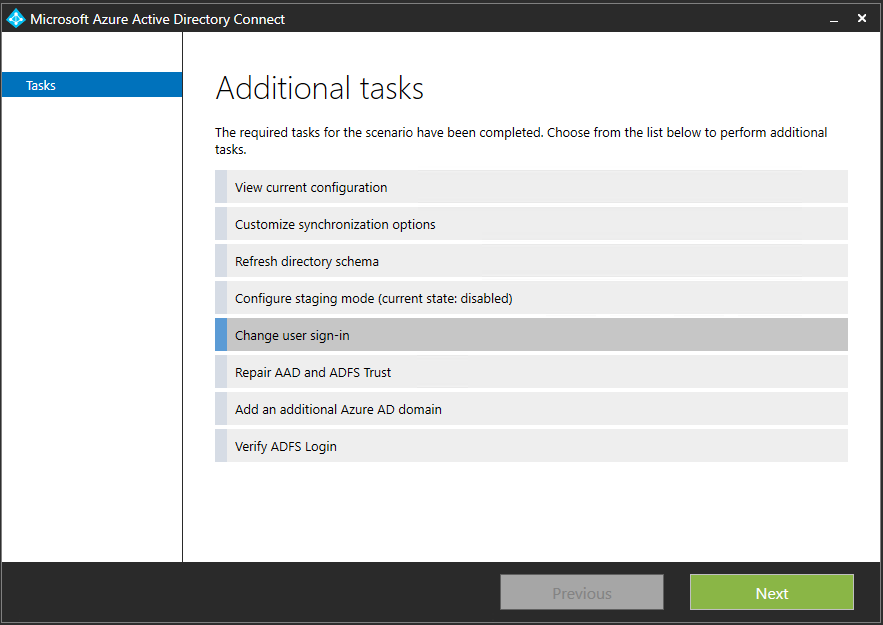
On the next page, you're asked to provide the credentials for Microsoft Entra ID.
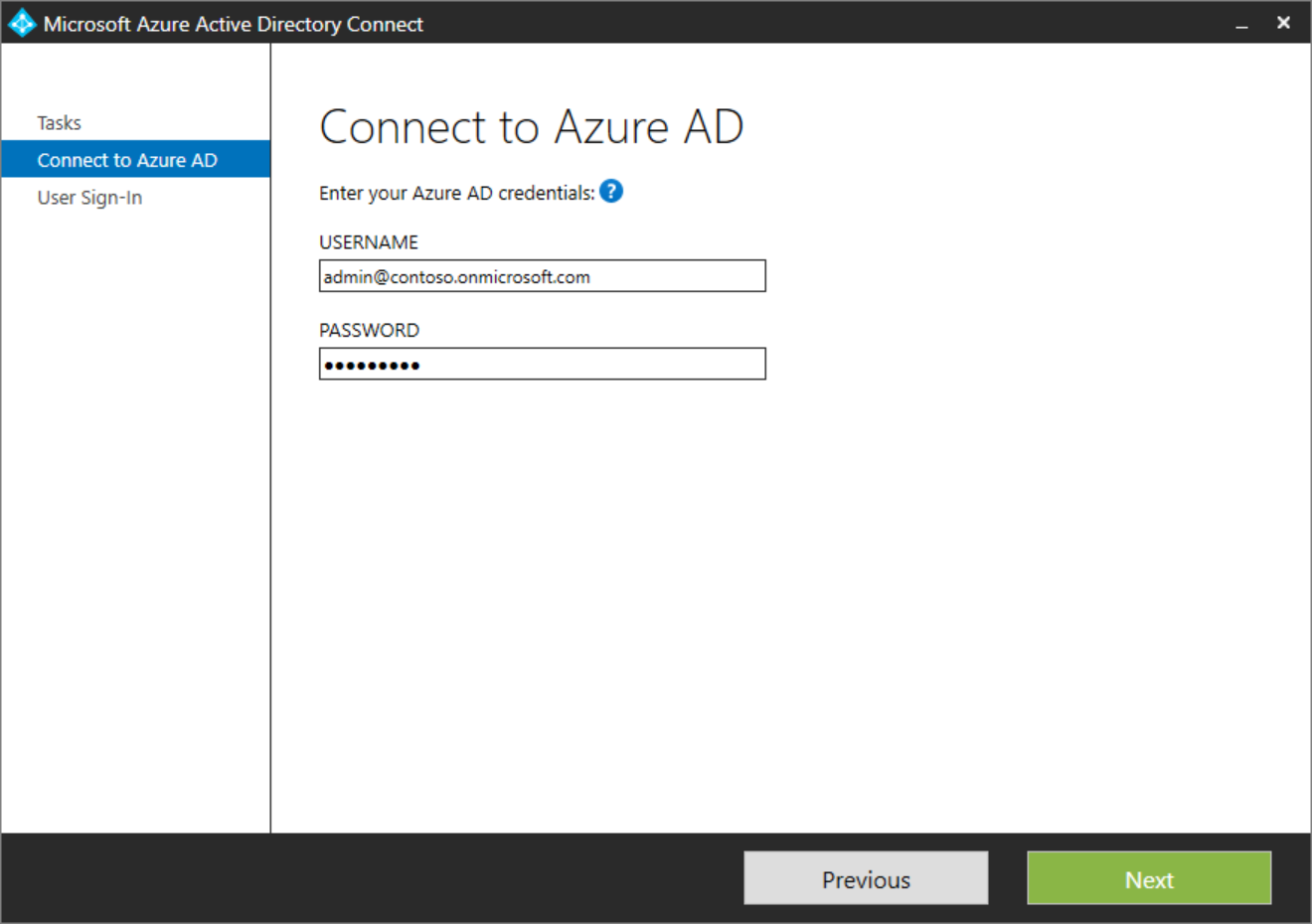
On the User sign-in page, select the desired user sign-in.
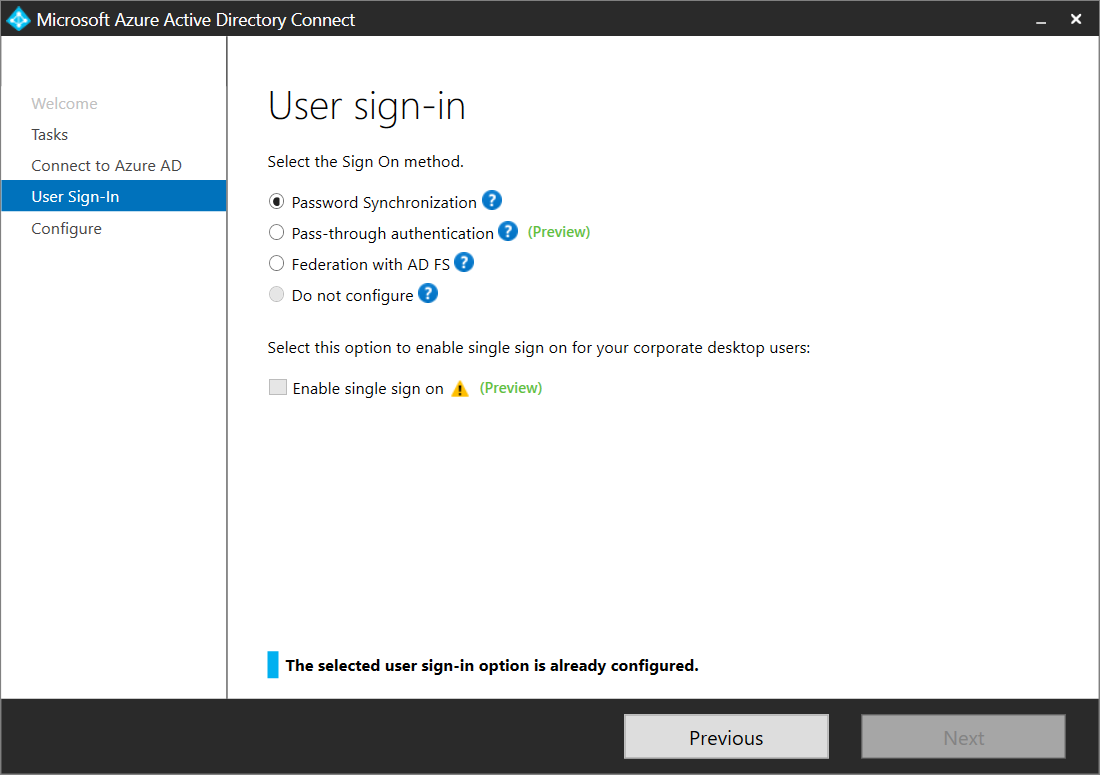
Note
If you're only making a temporary switch to password hash synchronization, then select the Do not convert user accounts check box. Not checking the option will convert each user to federated, and it can take several hours.
Next steps
- Learn more about integrating your on-premises identities with Microsoft Entra ID.
- Learn more about Microsoft Entra Connect design concepts.
Feedback
Coming soon: Throughout 2024 we will be phasing out GitHub Issues as the feedback mechanism for content and replacing it with a new feedback system. For more information see: https://aka.ms/ContentUserFeedback.
Submit and view feedback for